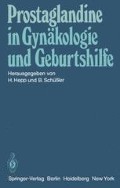Zusammenfassung
Prostaglandine (PG) sind in allen Gestationsstadien geeignet, die Uterusmuskulatur zu stimulieren. Diese Wirkung kann therapeutisch zur Geburtseinleitung und zur vorzeitigen Beendigung intakter und gestörter Schwangerschaften genutzt werden (1). Das Risiko systemischer Komplikationen (Bronchospasmus, Herz-Kreislauf-Versagen, Krampfanfälle) sowie die hohe Rate an Nebenwirkungen, besonders von Seiten des Gastrointestinaltrakts, schränkte das Spektrum der möglichen Anwendungen der PG der ersten Generation ein. Diese Prostaglandine wurden bisher bevorzugt nur jenseits der 12. Schwangerschaftswoche (SSW) angewendet, da der mit ihnen durchgeführte Schwangerschaftsabbruch weniger komplikationsträchtig als allein operative Methoden ist (2, 3). In den letzten Jahren wurden Prostaglandinderivate entwickelt, deren substanzbezogenes Risiko im Vergleich zu den natürlichen Prostaglandinen deutlich geringer ist (4–6). Im vorliegenden Beitrag wird daher einer kritischen Bestandsaufnahme der derzeitigen Möglichkeiten zur medikamentösen Induktion eines Aborts Priorität eingeräumt.
Access this chapter
Tax calculation will be finalised at checkout
Purchases are for personal use only
Preview
Unable to display preview. Download preview PDF.
Literatur
Karim SMM (1975) Prostaglandins and reproduction. MTP Press LtD., Lancaster
Brenner WE (1975) The current status of prostaglandins as abortifacients. Am J Obstet Gynecol 123: 306
Bygdeman M (1978) Comparison of prostaglandin and hypertonic saline for termination of pregnancy. Obstet Gynecol 52: 4
Hess H-J, Bindra SJ, Constantine JW, Elger W, Loge O, Schillinger E, Losert W (1977) Pharmacology of 16-phenoxy-w-tetranor PGE2-methylsulfonamide, a tissueselective antifertility prostaglandin. IRCS Med Sci 5: 68
Schmidt-Gollwitzer M, Schmidt-Gollwitzer K, Schüßler B, Koch R, Nevinny-Stickel J (1977) Erste Erfahrungen mit einem neuen Prostaglandin E2-Derivat. Geburtshilfe Frauenheilkd 37: 1030
Lichtenegger W (1977) Abortinduktion mit Prostaglandin F2alpha und einem neuen E2-Derivat. Wien Med Wochenschr 127: 536
Cates W Jr, Grimes DA (1981) Morbidity and mortality of abortion in the United States. In: Hodgen JE (ed) Abortion and sterilization. Academic Press, London, p 155
Statistisches Bundesamt Wiesbaden (1979) Schwangerschaftsabbrüche. Gesund-heitswesen Reihe 3. Kohlhammer, Mainz
Haensel W, Barthel W, Stockhammer P, Schlüter K (1981) Schwangerschaftsab- bruch in Deutschland weiterhin problematisch—ist Sulproston eine Lösung ?—Frauenarzt 22: 113
Bräutigam HH (1980) Zur Frage der Spätkomplikationen des legalen Schwan-gerschaftsabbruches in der Bundesrepublik. 43. Tagung der Deutschen Gesellschaft für Gynäkologie und Geburtshilfe, Hamburg
Beller FK, Rosenberg M, Kolker M, Douglas G (1972) Consumptive coagulopathy associated with intra-amniotic infusion of hypertonic salt. Am J Obstet Gynecol 112: 534
Haensel W, Dengler H-M, Stockhammer P (1977) Vorzüge der transzervikalen extraamnialen Rivanolinstillation bei der Interruptio. Geburtshilfe Frauenheilkd 37: 1050
Schmidt-Gollwitzer K, Schüßler B, Elger W, Schmidt-Gollwitzer M (1979) Neue therapeutische Möglichkeiten bei der Beendigung intakter und gestörter Schwangerschaften: Erfahrungen mit dem Prostaglandin E2-Derivat Sulproston. Geburtshilfe Frauenheilkd 39: 667
Heinzl S, Winkler C (1981) Aborteinleitungen im zweiten und dritten Trimenon mit Sulproston. Geburtshilfe Frauenheilkd 41: 231
Karim SMM (1979) Prostaglandins in obstetrics and gynecology. In: Friebel K, Schneider A, Würfel H (eds) International Sulprostone Symposium. Medico-Scientific Series of Schering AG, Berlin, p 7
Schmidt-Gollwitzer K, Schüßler B, Elger W, Schmidt-Gollwitzer M (1980) Improvement in artificial second-trimester abortion with a new tissue-selective prostaglandin E2-derivative. Am J Obstet Gynecol 137: 867
Haller U, Kubli F (1978) Klinische Nebenwirkungen der Prostaglandine bei Abortinduktion. Gynäkologe 11: 39
Karim SMM, Ratnam SS (1978) Termination of second trimester pregnancy with intramuscular administration of 16-phenoxy-w-tetranor PGE2-methylsulfonamide (SHB 286). Obstet Gynecol 6: 146
Harlap S, Shiono PH, Ramcharan S, Berendes M, Pellegrin F (1979) A prospective study of spontaneous fetal losses after induced abortion. N Engl J Med 301: 677
Bygdeman M: Persönliche Mitteilung
Schmidt-Gollwitzer K, Hoebich D, Hardt W, Schüßler B, Schmidt-Gollwitzer M (1981) Induction of abortion with sulprostone, a uteroselective prostaglandin E2 derivative: intramuscular route of application. Int J Fertil 26: 86
Wiechell H (1979) Ambulanter Schwangerschaftsabbruch durch einzeitige intramurale Applikation des Prostaglandin-Derivates SHB 286 (Sulproston). Geburtshilfe Frauenheilkd 39: 401
Haspels AA: Persönliche Mitteilung
Kühnle H, Grande P, Kuhn W (1977) Vermeidung dilatationsbedingter Komplikationen beim Schwangerschaftsabbruch durch intrazervikale Applikation eines prostaglandinhaltigen Gel. Geburtshilfe Frauenheilkd 37: 675
Lippert TH (1979) The use of prostaglandin gel in obstetrics and gynecology. Arch Gynäkol 227: 171
Author information
Authors and Affiliations
Editor information
Editors and Affiliations
Rights and permissions
Copyright information
© 1981 Springer-Verlag Berlin Heidelberg
About this paper
Cite this paper
Schmidt-Gollwitzer, M., Schmidt-Gollwitzer, K. (1981). Abortinduktion mit Prostaglandinen. In: Hepp, H., Schüßler, B. (eds) Prostaglandine in Gynäkologie und Geburtshilfe. Springer, Berlin, Heidelberg. https://doi.org/10.1007/978-3-642-68362-6_32
Download citation
DOI: https://doi.org/10.1007/978-3-642-68362-6_32
Publisher Name: Springer, Berlin, Heidelberg
Print ISBN: 978-3-540-11221-1
Online ISBN: 978-3-642-68362-6
eBook Packages: Springer Book Archive

